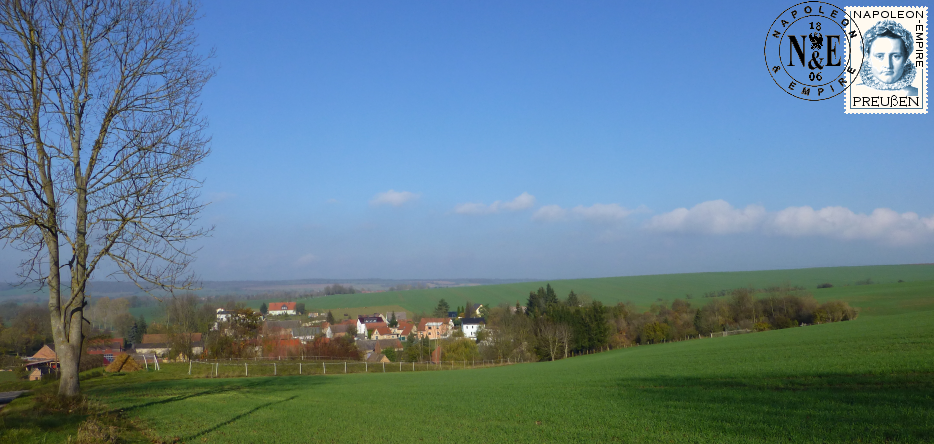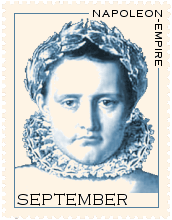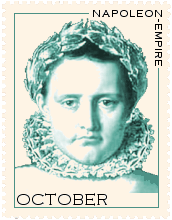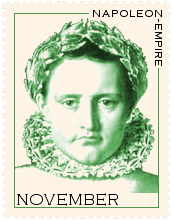The Campaign of 1806 in Prussia
day by day
Following the Battle of Austerlitz on December 2nd, 1805, a Franco-Prussian alliance treaty was signed on December 15, and a peace treaty with Austria on the 26 in Pressburg [today Bratislava]. Russia, however, was still at war.
As a result of the creation of the Confederation of the Rhine [Rheinbund] on July 12, 1806 and the dissolution of the Holy Roman Empire on August 6, a new coalition against France (the fourth one) comprising England, Russia, Prussia, Sweden and Portugal was created on October 6, 1806.
The response of Napoleon I, who had prudently anticipated this resumption of hostilities by keeping the Grande Armée in Germany, was dazzling. This new campaign would see the Prussian army almost annihilated eight days later and French troops would enter Berlin before the end of the month!

We followed the movements of the Emperor and the Grand Army day after day, and photographed the places of this campaign, mainly the fields of the double battle of Auestaedt and Jena, distant from each other by hardly more than twenty kilometers. Fortunately time has hardly disfigured them, to such an extent that one could sometimes expect to see a company of grenadiers emerge from a village, or a group of Uhlans from behind a hedge ...
September 1806

- September 25 - Having received a letter the day before from Marshal Louis-Alexandre Berthier reporting preparations for war and troop movements of the Prussians not far from the border, Napoleon set off for the army. Accompanied by the Empress Joséphine, he left the Castle of Saint-Cloud at 4:30 a.m., heading east. He dined in Châlons, then continued his journey at night.
- September 26 - After passing through Verdun, he reached Metz around 2 p.m., inspected its fortifications during the afternoon and left the city at 10 p.m., heading for Saarbrücken via Saint-Avold.
- September 27 - He passed through Kaiserslautern, then turned northeast towards Mainz, capital at that time of the Mont-Tonnerre department.
- September 28 - Arriving in Mainz early in the morning, he took leave of Josephine, who settled with her niece Stéphanie of Baden in the Hotel of the Teutonic Order [Deutschhaus] (the Empress would remain in Mainz until January 28, 1807). Later in the day, Napoleon had an interview with General Antoine-Henri Jomini.
- September 29 and 30 - The Emperor devoted these two entire days to intense epistolary activity and preparation for the operations to come.
October 1806

- October 1st - Napoleon left Mainz around 10 p.m., heading east-northeast.
- October 2nd - He arrived around 1 a.m. in Frankfurt-am-Main, where he had lunch at the Thurn und Taxis Palace, the residence of the Prince Primate and Grand Duke of Frankfurt, Karl Theodor von Dalberg [this palace, badly damaged during World War II, was subsequently demolished and then partially rebuilt ]. He then continued on to Hessentheim [we have not found a trace of a place named so, perhaps Hessenthal?], Triefenstein and Würzburg, where he stayed at the Grand Duke's palace, remaining in that city until the 6th.
- October 4 - He spoke with King Friedrich I of Württemberg , whom he had met the previous year at the start of the German campaign, who had become king on 1 January 1806 as a reward for his support of the French Empire.
- October 6 - Napoleon left Würzburg around 3 o'clock, had lunch at Burgwindheim [49.82731, 10.59844] 50 kilometers to the east and arrived in Bamberg, 26 kilometers further, at 1 pm. He settled in the Neue Residenz [49.89161, 10.88207] [this royal palace would experience a tragic episode in 1815, since it was from one of its third-floor windows that Marshal Berthier would fell into the void and found his death].
- October 8 - Napoleon left Bamberg at three o'clock for Kronach, 56 kilometers to the northeast, which he reached six hours later. From there, he reconnoitered about twenty kilometers further on the heights of the left bank of the river Saale.
- October 9 - Having left Kronach at 3 o'clock, he passed through Nordhalben [50.37399, 11.51255] and then continued through the Franconian Forest to Heiligen-Ebersdorf. He then went to Schleiz, where in the afternoon a first battle took place against the Prussians of General Bogislav Friedrich Emanuel von Tauentzien , then returned to spend the night at Ebersdorf Castle [50.48427, 11.66591].
- October 10 - He left Ebersdorf at 11 o'clock and went to the battlefield of Schleiz conquered the day before. A few dozen kilometers away, the Battle of Saalfeld saw the V Corps of the Grand Army commanded by Marshal Jean Lannes defeated the vanguard of the army of General Friedrich Ludwig zu Hohenlohe-Ingelfingen commanded by Prince Louis-Ferdinand of Prussia , who was killed by a sabre blow during a charge. In the evening, Napoleon slept in Schleiz.
- October 11 - He left Schleiz at 3 o'clock in a north-northeast direction, went to Auma 16 kilometers away, then pushed on to Gera and returned to sleep in Auma, at the Haaseschen Haus on the Marktplatz [current no. 9].
- October 12 - He returned to Gera.
- October 13 - He left Gera in the morning, passing through Langenberg [50.91961, 12.05275], Bad Köstritz [50.93072, 12.00763], Lobeda [50.88222, 11.62333], Roda [50.85789, 11.72743] and Ziegenhain [50.91972, 11.62500], then arrived in Jena between 2 and 3 p.m. After stopping under the lime trees of the Großherzoglich Schloss [this grand-ducal castle was destroyed around 1905, it was located on the site of the current Friedrich Schiller University], he left the city by the northwest and climbed the slopes of the Landgrafenberg , a promontory near the village of Cospeda , which offered a panoramic view . There he chose the location of his bivouac at the place called Windknollen [this place is marked by a commemorative stone named Napoleonstein ] [50.94512, 11.57146]
- October 14 - This day was that of the double battle of Auerstaedt [Auerstedt] and Jena. On the battlefield of Auerstaedt, Marshal Louis-Nicolas Davout at the head of the III Corps of the Grande Armée single-handedly defeated the bulk of the Prussian troops, commanded by General Charles-William-Ferdinand, Duke of Brunswick-Wolfenbüttel , then after the latter's serious injury by the King of Prussia Frederick William III himself. Simultaneously, Napoleon found himself confronted on the battlefield of Jena with different detachments placed under the command of Prince Frederick Louis of Hohenlohe-Ingelfingen . Around one o'clock in the morning, he left the bivouac in a thick fog to go and reconnoiter the outposts in the company of General Louis-Gabriel Suchet. At 6 o'clock, he went to the front line to harangue the battalions of Marshal Lannes's V Corps, not far from Krippendorf and Vierzehnheiligen , and directed operations on the spot until around 10:30. Then around noon, with the arrival of reinforcements (notably Jean-de-Dieu Soult at the head of two divisions of the IV Corps), Napoleon ordered the charge, which would rout the Prussians. At the end of the battle, at 4 o'clock, he pushed on to Weimar, 16 kilometers to the west, then came to spend the night in a hostel in Jena.
- October 15 - Napoleon left Jena at 1 p.m. for Weimar, where he slept at the Ducal Palace [Weimarer Stadtschloss]. He would stay there until the 17th.
- October 17 - Leaving Weimar around noon, heading east-northeast, he crossed the battlefield of Auerstaedt , then went to meet Marshal Davout at Naumburg an der Saale, a town where he spent the night.
- October 18 - He left Naumburg at noon, crossed the battlefield of Rossbach where he had the monument commemorating the victory in 1757 of the Prussians over the Franco-Imperial coalition of Louis XV and Maria Theresa of Austria torn down, then headed north-northeast and slept at Merseburg.
- October 19 - After reviewing the Guard, he left Merseburg at 1 p.m. and arrived in Halle two hours later, where he drafted, in evasive terms, a response to a request for a suspension of arms issued on October 15 by the King of Prussia. He would remain in Halle until the day after tomorrow.
- October 21 - He left Halle at 10 a.m., still heading north-northeast, passing through Zörbig and reaching Dessau, at the confluence of the Mulde and Elbe rivers, before 7 p.m. There he stayed at the Prince of Anhalt.
- October 22 - Leaving Dessau at 10 a.m., he headed for Wittenberg, 32 kilometers to the east. He sent his Grand Marshal of the Palace, Géraud Michel Duroc, to confer with the Marquis Girolamo Lucchesini , who had brought a peace proposal from the King of Prussia, which ultimately would not come to fruition.
- October 23 - He left Wittenberg at 10 a.m. and, surprised by a hailstorm, found refuge in a hunting lodge in Kropstädt, 13 kilometers to the northeast [51.96083, 12.74583].
- October 24 - He left around 5:00, passed through Marzahna and Beelitz and arrived in Potsdam around 10:30. He stayed at the Stadtschloss [completely burned down in 1945 during the Second World War, then demolished in 1959-60, its exterior being rebuilt in 2010-2013], then went to visit the Sanssouci Palace two kilometers away.
- October 25 - The Emperor reviewed his Guard in the courtyard of the Stadtschloss.
- October 26 - In the morning, he went to pay his respects at the tomb of King Frederick II (1740-1786), in the crypt of the Garnisonkirche [hit by the bombings of April 1945, the church was then destroyed in June 1968 by the communist regime of the GDR] in Potsdam. He then received Prince Franz Ludwig von Hatzfeldt , who had come to bring him the keys to Berlin. Around 1 p.m. he went to Spandau, then settled in at Charlottenburg Palace [52.51948, 13.2959], west of Berlin.
- October 27 - Napoleon received General Friedrich Wilhelm Christian von Zastrow, emissary of the King of Prussia, in Charlottenburg in the morning. At 3 p.m. he entered Berlin through the Brandenburg Gate [Brandenburger Tor] . He then moved into the royal palace [Königliche Schloss, partially damaged and burned in 1945, destroyed in 1950 by the GDR, then rebuilt between 2013 and 2020] .
- October 28 - He signed a decree in the morning ordering the arrest and trial of Prince Hatzfeld, for treason and espionage during his representation mission the day before. In the afternoon, he received the tearful wife, eight months pregnant, to whom he granted the pardon of her husband [several paintings illustrate this act of gallantry, including that of Marguerite Gérard ]
- October 28 to 31 - He held several reviews of his troops in Berlin.
November 1806

- November 1st - Napoleon still stayed in Berlin, where he remained until November 24, attending a daily parade in front of the royal castle, and regularly reviewing the divisions of the Grande Armée. He also closely followed the situation in the east, where the Prussians and Russians had agreed to continue the fight.
- November 21 - He signed a decree in eleven articles establishing the continental blockade, known as the "Berlin Decree", which prohibited all trade with the United Kingdom.
- November 22 - He learned of the arrival of a Russian corps in Warsaw [Warszawa].
- November 24 - Napoleon had post relays prepared so that he could quickly join the army.
- November 25 - He left Berlin at 3 a.m. for Kustrin [Kostrzyn nad Odrą, today in Poland] [52.58746, 14.65025], on the right bank of the Oder River, where he arrived at 10 a.m.; the Prussian Campaign was over, the Polish Campaign began.
 All of Napoleon's movements from 1769 to 1821
All of Napoleon's movements from 1769 to 1821
Photos credits
Photos by Lionel A. Bouchon.Photos by Didier Grau.
Photos by Michèle Grau-Ghelardi.
Photos by Marie-Albe Grau.
Photos by Floriane Grau.
Photos by various authors. Thanks to Mrs. Christiane Deshaies-Da Luz for the photos she kindly offered us.